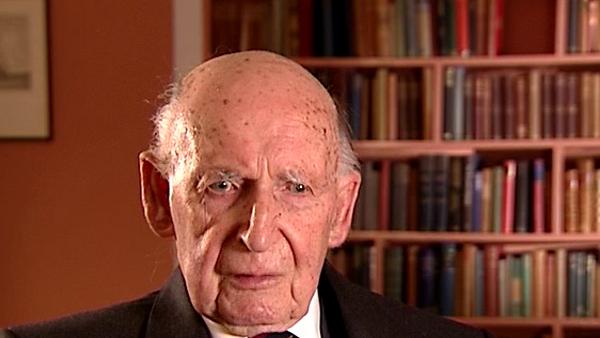NEXT STORY

A White Paper by the Public Accounts Committee
RELATED STORIES

NEXT STORY

A White Paper by the Public Accounts Committee
RELATED STORIES



Unfortunately John Davis, who was then one of my senior colleagues, who new everything about orbits... we had asked him to go to East Germany, for a reason, which I will go back to later on, because that was entirely scientific thing concerned with fireballs and their orbits. And so, at this critical time, the one member of my staff who could have helped to decipher the orbit of the missile was away, and not... and out of communication in Eastern Germany. I had another young man, also by the name of Davis, who subsequently went to Australia with Hanbury Brown, and I had an enormous map on my wall, and we, together, with the help of pins and string, got some idea of the orbit of the missile.
And then another trouble happened. The radar apparatus, on which we were getting echoes from the moon broke down, and Jamie Evans, a brilliant young man, who was responsible for that – and I'm going to talk about his work later on – could find absolutely no reason for why it had gone wrong. So one day I was disconsolately walking down to where this apparatus was in one of the Orlit Buildings, and I was encountered by Greenhow, who had a four-metre radar system working on measuring the heights of meteors. And he produced from his pocket an envelope on which he had scribbled some calculations, and he said, 'Look here'. I said, 'What do you want?' He said, 'Look here; if you'll transfer my transmitter, my four-metre transmitter, to the top of the towers, and connect it to... and modify the telescope, I think you'll have enough sensitivity to detect this missile'. So we did that.
And the next night or so, we tried the telescope on... using this four-metre transmitter, and directed it to where we thought this missile might be. Well, we got some vague sort of echo, but it was nothing conclusive. However, on the next night, I was in the laboratory, which is something we called the radiant hut, which is where the receiving apparatus was, and suddenly, before midnight, I saw the usual number of transient echoes from meteors and so on, on the tube, and suddenly a most dramatic echo. A huge echo, starting on one side of the time base, and moved, fluctuating over, moving and moving along the time base. And fortunately, it was photographed. That was the echo of the intercontinental missile travelling over the Lake District at a speed of 17,000 miles an hour.
Now, the Jodrell – the Control Room, the Control Building – was packed with the press. You had no means of getting rid of them. And so they assembled, and we developed this photograph, and I projected it to a packed media, cameramen, newspapermen, in the small lecture room, after midnight, on that day. This wonderful echo is reproduced in many of my books. The only instrument in the Western world, which could detect the launching of the Sputnik, and the press recognised it immediately, that this was the intercontinental missile. Well, the next day, the media, instead of regarding us as wasters of money, and a wastage of public money, they reversed completely, and we became front-page news, and solutions had to be found.
Bernard Lovell (1913-2012), British radio astronomer and founder of the Jodrell Bank Observatory, received an OBE in 1946 for his work on radar, and was knighted in 1961 for his contribution to the development of radio astronomy. He obtained a PhD in 1936 at the University of Bristol. His steerable radio telescope, which tracked Sputnik across the sky, is now named the Lovell telescope.
Title: Problems with the radar and detecting the Sputnik missile
Listeners: Megan Argo Alastair Gunn
Megan Argo is an astronomer at the University of Manchester's Jodrell Bank Observatory researching supernovae and star formation in nearby starburst galaxies. As well as research, she is involved with events in the Observatory's Visitor Centre explaining both astronomy and the history of the Observatory to the public.
Alastair Gunn is an astrophysicist at Jodrell Bank Observatory, University of Manchester. He is responsible for the coordination and execution of international radio astronomical observations at the institute and his professional research concerns the extended atmospheres of highly active binary stars. Alastair has a deep interest and knowledge of the history of radio astronomy in general and of Jodrell Bank in particular. He has written extensively about Jodrell Bank's history.
Tags: East Germany, Australia, Sputnik 1, Lake District, Jodrell Bank, John Davis, Robert Hanbury Brown, Jamie Evans
Duration: 5 minutes, 20 seconds
Date story recorded: January 2007
Date story went live: 05 September 2008